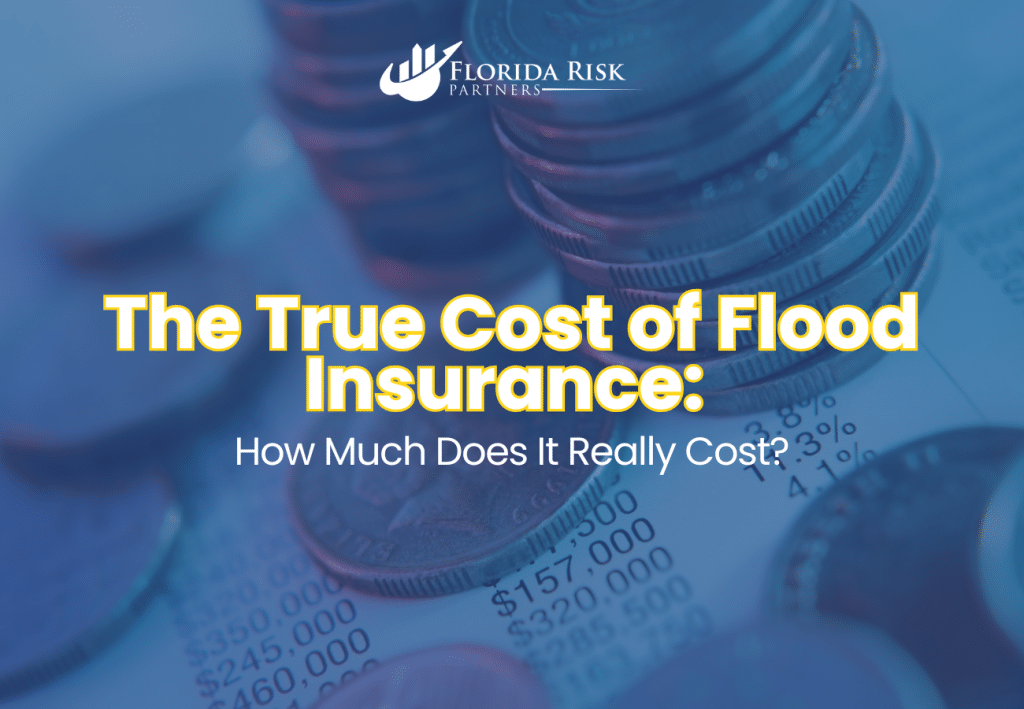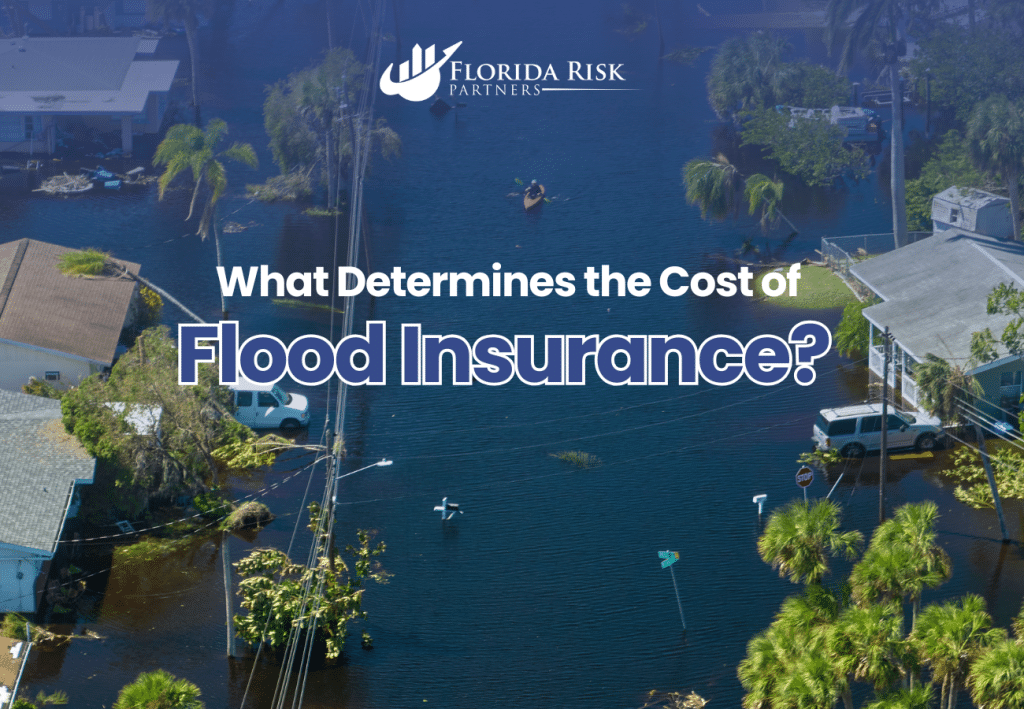-
Main Office: 1434 E. Bloomingdale Ave Valrico, FL 33596-6110
-
Phone: (888) 601-6660
-
Email: info@floridariskpartners.com

Flooding can be one of the most devastating natural disasters to impact a home or business. Unfortunately, many property owners don’t think about flood insurance until it’s too late, often assuming it’s either unnecessary or prohibitively expensive. The reality is that the cost of flood insurance varies widely based on several factors, and for most people, it’s much more affordable than the price of repairing flood damage out of pocket.
In this post, we’ll explore what determines the cost of flood insurance, how different factors like flood zones and property characteristics affect premiums, and why even properties in low-risk areas should consider coverage. As part of our Flood Insurance 101 series, this guide will help you understand the true cost of flood insurance and why it’s a smart investment for any homeowner or business owner.
What Determines the Cost of Flood Insurance?
Flood insurance premiums are influenced by several factors that assess the level of risk a property faces. Understanding these factors is key to knowing how much you’ll pay for coverage and what you can do to reduce your premiums.
1. Location and Flood Zone
One of the biggest factors influencing the cost of flood insurance is the flood zone your property is located in. FEMA designates flood zones based on the likelihood of a flood occurring in that area. Properties in high-risk flood zones (also called Special Flood Hazard Areas – SFHAs) are more likely to experience flooding, and therefore have higher premiums. In contrast, properties in moderate- to low-risk flood zones generally have lower premiums.
If your property is in a Zone A or Zone V (coastal areas at risk for storm surge and flooding), you can expect to pay higher rates. However, even if you’re in a Zone X (moderate- or low-risk), purchasing flood insurance is still a smart decision because floods can and do happen outside high-risk areas. More than 20% of flood insurance claims come from properties in low-risk zones. Check your flood zone to understand your property’s risk level.
2. Property Elevation
For properties in high-risk flood zones, elevation is a critical factor in determining flood insurance costs. The base flood elevation (BFE) is the level at which floodwaters are expected to rise during a 100-year flood. If your property is elevated above the BFE, your risk of flooding decreases, and your premiums will likely be lower. Conversely, if your property is below the BFE, premiums will be higher because the risk of flooding is greater.
If your property is at risk, investing in elevating your home or other flood mitigation measures can significantly reduce your premiums. In some cases, elevating your property by just a few feet above the BFE can result in substantial savings.

3. Coverage Amount and Deductibles
The amount of coverage you choose for both building and contents protection also affects the cost of flood insurance. Building coverage protects the structure of your home or business, including walls, floors, and essential systems like electrical and plumbing. Contents coverage protects your personal belongings, furniture, and equipment inside the property.
FEMA’s National Flood Insurance Program (NFIP) offers up to $250,000 in building coverage for residential properties and up to $500,000 for commercial properties. Contents coverage is available up to $100,000 for residential and $500,000 for commercial. You can choose coverage limits based on the value of your property and belongings, but higher coverage limits generally result in higher premiums.
Similarly, the deductible you choose impacts your premium. A higher deductible means you’ll pay more out of pocket if a flood occurs, but your annual premiums will be lower. On the other hand, a lower deductible reduces your out-of-pocket costs during a claim but increases your premiums.
To see what coverage options make sense for your situation, get a flood insurance quote today.
4. Property Characteristics
The age, construction type, and overall condition of your property also play a role in determining flood insurance costs. Older properties or those constructed without modern flood mitigation measures tend to have higher premiums because they are more vulnerable to flood damage.
Homes or businesses built with flood-resistant materials or with advanced drainage systems often qualify for lower premiums. Additionally, homes with basements may face higher premiums since they are more likely to experience flood damage.
Learn more about flood insurance coverage to see how your property’s unique features affect your rates.
5. Private vs. NFIP Flood Insurance
While the National Flood Insurance Program (NFIP) is the most well-known provider of flood insurance, many private insurance companies also offer flood coverage. Private flood insurance often provides higher coverage limits, additional customization options, and in some cases, more competitive rates than the NFIP. However, premiums for private insurance can vary more widely depending on your location and risk factors.
For high-value properties or those needing higher coverage than the NFIP provides, exploring private insurance options can be a good choice. Compare private flood insurance options to see what’s best for you.
How Much Does Flood Insurance Cost for Different Types of Properties?
The cost of flood insurance depends on the type of property you’re insuring, whether it’s residential, commercial, or a rental property. Below, we’ll look at how premiums can vary for different property types.

1. Residential Flood Insurance
For homes in low- to moderate-risk zones, flood insurance through the NFIP typically costs around $400 to $700 per year. In high-risk zones, premiums can range from $1,000 to $4,000 or more annually, depending on the home’s elevation, flood zone, and other factors. Private flood insurance options may be more affordable for some homeowners, depending on the provider and coverage options.
Homeowners in high-risk areas can also explore ways to lower their premiums through elevation and other mitigation measures. Additionally, bundling flood insurance with other types of coverage, such as home or auto insurance, may lead to discounts from certain insurers.
2. Commercial Flood Insurance
For business owners, the cost of flood insurance is generally higher due to the larger property values and potential for greater losses. Premiums for commercial flood insurance can range from $2,000 to $10,000 per year or more, depending on the size of the building, its location, and the type of business. Higher-value commercial properties may need to explore private flood insurance to obtain adequate coverage beyond NFIP limits.
3. Rental Property Flood Insurance
If you own a rental property, having flood insurance is essential for protecting your investment. Rental properties in moderate- to low-risk zones often see premiums in the range of $500 to $1,000 per year, while high-risk zones can push premiums higher, depending on the building’s value and location.
Rental property owners should carefully consider both building and contents coverage, especially if they furnish the property or have a property management office on-site. Protecting the building’s infrastructure, as well as any personal property within, can save you from significant out-of-pocket expenses if a flood occurs.
For a more personalized estimate, you can calculate your flood insurance premium using our online tool.
How to Save Money on Flood Insurance
While the cost of flood insurance depends on several factors, there are steps you can take to reduce your premiums and make coverage more affordable:
- Elevate your property: Homes and businesses that are elevated above the base flood elevation (BFE) can qualify for lower premiums. This is one of the most effective ways to lower flood insurance costs, especially in high-risk zones.
- Flood-proof your property: Installing flood barriers, improving drainage, and using water-resistant materials can help reduce flood risk and may lead to lower premiums.
- Bundle your policies: Some insurers offer discounts when you bundle flood insurance with other types of coverage, such as home, business, or auto insurance.
- Choose a higher deductible: If you’re comfortable with paying more out of pocket in the event of a flood, opting for a higher deductible can significantly lower your annual premium.
To see how much you could save, get your personalized flood insurance quote today.
Conclusion: Understanding the True Cost of Flood Insurance
The cost of flood insurance is influenced by many factors, including your property’s location, elevation, and coverage needs. While premiums can vary widely depending on these factors, the potential financial burden of repairing flood damage without insurance far outweighs the cost of coverage. Even properties in low-risk zones can benefit from affordable flood insurance that protects against unexpected flooding events.
Whether you’re a homeowner, business owner, or rental property investor, understanding the true cost of flood insurance is crucial for protecting your assets. Don’t wait until it’s too late—get your flood insurance quote now and ensure your property is covered.
Call Us Or
Schedule an Appointment
Select an agent below to view our online calendars and select a day and time that works best for you or call us directly at 888-601-6660. When you use our online calendars, you will receive an email with more information.



